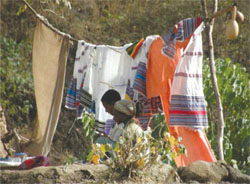Treatment and prevention of scabies
A chemical called benzyl benzoate lotion (BBL, 25% solution) is used for the treatment of scabies. In adults, the lotion should be applied to the whole body, including the neck, face and ears – but taking care not to get it into the eyes, nose or mouth. Use a cotton swab to squeeze the lotion under the ends of the fingernails and toenails, where mites can hide. Tell the person not to wash! Repeat the treatment the following day and advise the patient not to wash for another 24 hours.
Children should also be treated with BBL, but the advice is to apply the lotion every day for three days; on each day leave the lotion on the child's body for 13 hours, then wash it off.
Other people who have been in close contact with a child or adult with scabies should also be treated with BBL to avoid re-infection, and all clothes and bedding should be thoroughly washed with hot water and dried in sunlight (figure below).

Education on prevention of scabies should focus on explaining the transmission of the itchy mites and good personal hygiene, such as bathing and washing clothes frequently. The main control measures are early diagnosis and treatment of patients and contacts.
How do you tell the difference between the skin manifestations of scabies and onchocerciasis?
Severe itching of the skin is the common characteristic of both scabies and onchocerciasis. However, onchocerciasis has additional symptoms such as loss of skin colour and nodule formation, whereas scabies rashes are raised red pimples and flaky skin. Scabies occurs mainly in conditions of poverty and overcrowding where the mites can easily breed; whereas onchocerciasis is common in communities living near the fast-flowing water required by the insect vector (blackflies).